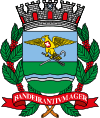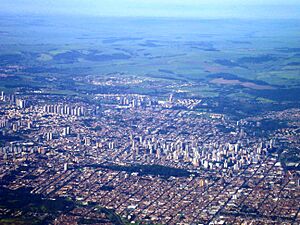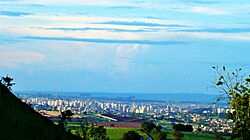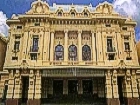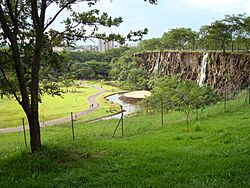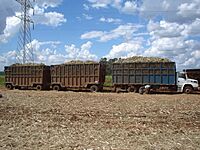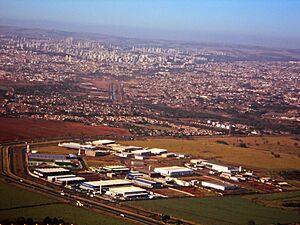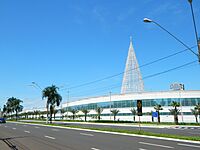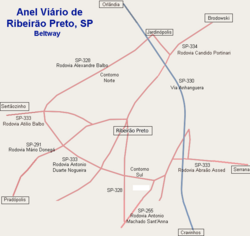Ribeirão Preto facts for kids
Quick facts for kids
Ribeirão Preto
|
|||
|---|---|---|---|
|
Municipality
|
|||
| Municipality of Ribeirão Preto | |||
|
From the top, from left to right: aerial view of downtown; Metropolitan Cathedral of Ribeirão Preto; interior of Theatro Pedro II; Choperia Penguin; Francisco Schmidt Coffee Museum; Mayor Luiz Roberto Jábali Park; partial panorama of the south zone of the city from Parque Prefeito Luiz Roberto Jábali.
|
|||
|
|||
| Nickname(s):
Capital Nacional do Agronegócio (Agribusiness National Capital) "California brasileira" ("Brazilian California")
|
|||
| Motto(s):
Bandeirantum Ager
|
|||

Location in São Paulo
|
|||
| Country | |||
| Region | Southeast | ||
| State | |||
| Founded | June 19, 1856 | ||
| Area | |||
| • Total | 650.9 km2 (251.3 sq mi) | ||
| Elevation | 526 m (1,726 ft) | ||
| Population
(2022)
|
|||
| • Total | 698,642 | ||
| • Density | 1,073.35/km2 (2,779.96/sq mi) | ||
| Postal Code |
14000-000
|
||
| Area code(s) | +55 16 | ||
| HDI (2010) | 0.800 – very high | ||
Ribeirão Preto is a city and a metropolitan area in the northeastern part of São Paulo state, Brazil. Its name means "Black Creek" in Portuguese.
It is the eighth-largest city in São Paulo state. Ribeirão Preto covers about 650.9 square kilometers (251.3 square miles). In 2021, its population was around 720,216 people. The larger metropolitan area has about 1,178,910 people. The city is about 313 km (194 miles) from the city of São Paulo. It is also 706 km (439 miles) from Brasília, Brazil's capital.
The city started around 1856 as a farming area. Coffee was its main product for a long time. But after 1929, coffee became less valuable. In the late 1900s, Ribeirão Preto started focusing on health, biotechnology, and information technology. Because of this, it was named a "Technological Center" in 2010. These new activities have helped the city become one of the richest in Brazil.
Ribeirão Preto is also a lively cultural hub. It has beautiful parks like Mayor Luiz Roberto Jábali Park and Maurilio Biagi Park. The city is home to the famous Pinguim Beerhouse and the historic Pedro II Theatre. Many exciting events happen here, such as the Agrishow Agricultural Fair and the João Rock Music Festival.
Contents
- History of Ribeirão Preto
- Population of Ribeirão Preto
- Ribeirão Preto Region
- Geography of Ribeirão Preto
- Fun Things to Do in Ribeirão Preto
- Sports in Ribeirão Preto
- Economy of Ribeirão Preto
- City Services and Education
- Getting Around Ribeirão Preto
- Media in Ribeirão Preto
- Famous People from Ribeirão Preto
- See also
History of Ribeirão Preto
Ribeirão Preto was founded on June 19, 1856. Early settlers were farmers and African slaves. They came from other parts of São Paulo and Minas Gerais. They were looking for good land for farming and raising animals. The city was built near a stream called Black Creek, which gave the city its name. The soil in this area was very fertile, meaning it was great for growing crops.
At first, people mainly raised cattle and grew food for themselves. In the 1870s, coffee farming began in Ribeirão Preto. Growing coffee quickly made the city rich and modern. By the 1880s, Ribeirão Preto became the world's biggest coffee producer. Coffee was called "green gold" because it brought so much wealth. This led to many people moving to the region, like a "gold rush."
The new Mogiana Railway helped people and goods move easily. It connected Ribeirão Preto to São Paulo and the port city of Santos. When slavery ended in Brazil in 1888, there was a need for new workers. Coffee farmers, called "coffee barons," encouraged people from other countries to come. Many immigrants arrived from Europe, especially Italy, Portugal, Spain, and Germany. People also came from Japan. They settled on coffee farms in Ribeirão Preto and nearby towns. Some Italian immigrants lived in a special area called "Núcleo Colonial Antonio Prado." This area, created in 1887, later became many of the city's northern and eastern neighborhoods. After the stock market crash in 1929, some immigrants even bought farms from their former bosses who had become poor.
Population of Ribeirão Preto
The people of Ribeirão Preto come from many different backgrounds. Besides the Native Amerindians who lived there first, the city's population includes descendants of Africans, Italians, Portuguese, Spanish, Japanese, Germans, and Lebanese. Many of these groups came after slavery ended in 1888. They were given land after working on farms. Descendants of enslaved African people are a large and important part of the population. Italians also arrived in huge numbers.
In 2019, Ribeirão Preto had 703,293 people. Its wider metropolitan area has about 1.7 million people.
Population Facts
Here are some facts from the 2010 Census:
- Total population: 605,114 people
- Most people live in the city (603,401), with fewer in rural areas (1,713).
- There were more women (314,828) than men (290,286).
- The city's Human Development Index (HDI) was 0.855, which is considered very high. This index measures things like health, education, and living standards.
- About 95.56% of people could read and write.
Ethnic Groups
| Ethnic groups | Percent |
|---|---|
| White | 63.6% |
| Mixed | 27.4% |
| Black | 8.0% |
| Asian | 0.8% |
| Amerindian | 0.1% |
Source: Census 2022
Ribeirão Preto Region
Ribeirão Preto is the main city of a large metropolitan area. This area has about 1.662 million people (as of 2017). It includes Ribeirão Preto and 33 other nearby cities.
Some of these cities are:
- Altinopolis
- Brodowski
- Batatais
- Cravinhos
- Guariba
- Jaboticabal
- Jardinópolis
- Sertãozinho
- And many more!
Geography of Ribeirão Preto
Climate in Ribeirão Preto
Ribeirão Preto has a tropical climate. This means it has rainy summers and dry winters. The hottest temperature ever recorded was 43.6 °C (110.5 °F) on October 29, 2012.
- Average temperature in Winter: 18.6 °C (65.5 °F)
- Average temperature in Summer: 23.9 °C (75.0 °F)
- Average yearly rainfall: 1508 mm (59.4 inches)
- Average humidity: 71%
| Climate data for Ribeirão Preto, elevation 632 m (2,073 ft), (1991–2020) | |||||||||||||
|---|---|---|---|---|---|---|---|---|---|---|---|---|---|
| Month | Jan | Feb | Mar | Apr | May | Jun | Jul | Aug | Sep | Oct | Nov | Dec | Year |
| Mean daily maximum °C (°F) | 30.0 (86.0) |
30.5 (86.9) |
30.2 (86.4) |
29.4 (84.9) |
26.8 (80.2) |
26.4 (79.5) |
27.0 (80.6) |
29.1 (84.4) |
30.6 (87.1) |
31.3 (88.3) |
30.4 (86.7) |
30.3 (86.5) |
29.3 (84.8) |
| Daily mean °C (°F) | 24.9 (76.8) |
25.0 (77.0) |
24.6 (76.3) |
23.3 (73.9) |
20.6 (69.1) |
19.9 (67.8) |
19.9 (67.8) |
21.6 (70.9) |
23.6 (74.5) |
24.8 (76.6) |
24.5 (76.1) |
24.8 (76.6) |
23.1 (73.6) |
| Mean daily minimum °C (°F) | 19.7 (67.5) |
19.5 (67.1) |
19.1 (66.4) |
17.3 (63.1) |
14.3 (57.7) |
13.3 (55.9) |
12.8 (55.0) |
14.1 (57.4) |
16.5 (61.7) |
18.3 (64.9) |
18.6 (65.5) |
19.4 (66.9) |
16.9 (62.4) |
| Average precipitation mm (inches) | 266.8 (10.50) |
209.8 (8.26) |
158.6 (6.24) |
65.1 (2.56) |
58.2 (2.29) |
26.8 (1.06) |
15.8 (0.62) |
16.7 (0.66) |
60.6 (2.39) |
103.9 (4.09) |
176.3 (6.94) |
237.0 (9.33) |
1,395.6 (54.94) |
| Source: Centro Integrado de Informações Agrometeorológicas | |||||||||||||
Rivers and Creeks
Ribeirão Preto has several important rivers and creeks:
- Pardo River
- Ribeirão Preto (Black Creek) – this creek gave the city its name!
- Retiro Saudoso Creek
- Tanquinho Creek
- Laureano Creek
- And many others, like California Creek and Olhos d'Água Creek.
Fun Things to Do in Ribeirão Preto
In the early 1900s, Ribeirão Preto was a very rich city. It had fancy mansions, European-style cafes, and even two opera houses. This was all thanks to the booming coffee business. One opera house was torn down, but the other, the "Pedro II Theatre," built in the 1920s, is still standing. It was restored and is now the third-largest opera house in Brazil. It's home to the Ribeirão Preto symphony orchestra.
Many exciting events happen in Ribeirão Preto every year:
- Agrishow: A huge international fair for farm technology.
- National Book Fair: A great event for book lovers.
- Tanabata Festival: A Japanese cultural festival.
- João Rock Music Fest: A popular music festival.
- Ribeirão Rodeo Music: A big rodeo event.
The city has a warm climate, so people love to go out in the evenings. There are many bars, from simple local spots to fancy pubs. Ribeirão Preto is also known for its local breweries.
Ribeirão Preto is a major center for business tourism in Brazil. It has many hotels and convention centers for big events.
Parks and Green Spaces
Ribeirão Preto has many beautiful parks, gardens, and a zoo.
- Fábio Barreto Municipal Forest: A great place to see nature.
- "Curupira" Park: Officially called Luís Roberto Jábali Park, it's a popular spot.
- Botanical Garden Park: Also known as Luís Carlos Raya Park, it's full of plants.
- Maurílio Biagi Ecological Park: Another lovely green space in the city center.
Theaters and Museums
Ribeirão Preto has several interesting museums and theaters:
- Theatro Pedro II: This is a famous opera house in the city center. It's the third largest of its kind in Brazil. It opened on October 8, 1930.
- Municipal Theatre: A modern theater that opened in 1969. It's also used for cultural events.
- Arena Theater: Located next to the Municipal Theatre.
Some important museums include:
- Coffee Museum Francisco Schmidt: Built in the 1950s, it has a huge collection of items about the history of coffee in São Paulo. You can see old coffee machines, carts, and photos from the "golden age" of coffee.
- Art Museum of Ribeirão Preto (MARP): A museum dedicated to art.
- Casa da Memória Italiana: The Italian Memory House, which tells the story of Italian immigrants.
Other theaters in the city are: Auxiliadora Theatre, Bassano Vaccarini Theatre, SESC Theatre, Minaz Theatre, Santa Rosa Theatre, and Sesi Theatre.
Cinema in Ribeirão Preto
Ribeirão Preto is a big center for movies in Brazil. It has the Kaiser Film Studios, which are huge film production facilities. These studios are in an old brewery building and are considered a historical site.
The city also has the largest film society in Brazil, Cineclube Cauim, with 900 seats. Plus, there are many modern movie theaters like UCI, Cinemark, and Cinepolis.
Carnival Celebrations
Ribeirão Preto is home to one of Brazil's oldest samba schools, "Bambas," founded in 1927. Samba schools are groups that perform samba music and dance during Carnival. Other samba schools include Embaixadores dos Campos Elíseos and Tradição do Ipiranga.
In 2010, the Águias de Ouro Samba School in São Paulo chose Ribeirão Preto as its theme for the Carnival parade. They showed the city's history with coffee, sugarcane, and agribusiness. There are also fun street carnival groups like "Os Alegrões."
Sports in Ribeirão Preto
Ribeirão Preto has two main soccer stadiums. One is Estádio Palma Travassos, home to Comercial FC. The other is Estádio Santa Cruz, home to Botafogo FC. Botafogo FC plays in important Brazilian soccer leagues.
A fun fact about Botafogo (often called Botafogo-SP) is that famous Brazilian soccer captains and brothers, Sócrates and Raí, started their careers there!
In 2017, a men's volleyball team called Vôlei Ribeirão was formed. They won a major league in 2018 and played in Brazil's top volleyball league until 2021. Their games were held at Cava do Bosque, a public sports center.
In 2021, a new skate park, RP Skate Park, opened at Maurilio Biagi Ecological Park. It's 4,000 square meters and was designed by world champion Bob Burnquist. It can host different skateboarding styles.
Ribeirão Preto hosted the Brazilian Youth Games from September 1 to 16, 2023. About 4,000 young athletes from all over Brazil competed in 18 different sports. The opening ceremony was at the Pedro II Theatre.
FIFA World Cup 2014 Training Center
Ribeirão Preto was chosen as a training center for the 2014 FIFA World Cup. The France national football team used the Santa Cruz stadium for their training. The Pedro II Theatre hosted their press conferences.
Economy of Ribeirão Preto
After the New York Stock Exchange crash in 1929, Ribeirão Preto's economy, which relied only on coffee, struggled. The city had to find new ways to make money. Since it was far from other big Brazilian cities, it became a center for services and trade for its local area.
A second big economic boost happened in the 1970s after the oil crises. Brazil needed new types of fuel. The solution was the "Pro-Álcool" program, which used ethanol (alcohol from sugarcane) as fuel. Farmers in Ribeirão Preto were encouraged to grow sugarcane. The fertile land quickly made the region the world's largest producer of alcohol and sugar. It produced 30% of Brazil's sugarcane alcohol fuel.
This sugarcane boom brought new wealth to the city. In the 1980s and early 1990s, it was even called the "Brazilian California." This made the city a fancy service center for Brazil and South America. However, it also attracted many people from poorer areas, leading to fast population growth and the creation of slums, called favelas.
Today, sugarcane is still the main crop grown in the area. Other crops include maize (corn), peanuts, and soybeans. Ribeirão Preto also makes many products, such as medical and dental supplies, animal feed, meat, dairy products, and beer. The city hosts "Agrishow" every year, which is one of Brazil's most important agricultural trade shows.
The airline Passaredo Transportes Aéreos has its main office in the city.
City Services and Education
Education in Ribeirão Preto
Ribeirão Preto is a strong educational center. In 2010, about 98.9% of people over 15 could read and write.
During the 1940s and 1950s, the city became known for its universities. In 1942, a large coffee farm was turned into an agricultural school. In 1952, this old farm became the site for a medical school of the University of São Paulo. This was the first part of the university's campus in Ribeirão Preto.
Many of the original farm buildings were kept and used for the new university. This makes its campus one of the most beautiful in Brazil. The University of São Paulo at Ribeirão Preto (USP-RP) has grown a lot. It now has eight different schools, including:
- School of Medicine
- School of Law
- School of Dentistry
- School of Nursing
- And more!
The growth of USP-RP encouraged many other schools and colleges to open in the city. There are also many private colleges, like Centro Universitário Barão da Mauá and Universidade Paulista (UNIP).
Ribeirão Preto also has a local office for AIESEC. This is the world's largest student-run organization. It helps young people develop leadership skills and become global citizens.
Science and Technology
Ribeirão Preto and its surrounding area are major centers for science and research in São Paulo state. They focus on health, engineering, and high technology. This makes the region an important hub for technology and education.
Ribeirão Preto's Technology Park helps new companies that focus on research and development. It especially supports businesses in health and biotechnology. The park has special labs and a business center to help these companies grow. The city is also a leader in information technology (IT). In 2010, the IT industry in Ribeirão Preto saw a 23% increase in income. The city also excels in bioenergy, being one of the world's biggest producers of sugar and ethanol.
Getting Around Ribeirão Preto
Public Transportation
Ribeirão Preto has a public transportation system with about 300 buses. They serve 113 different routes. Some routes use smaller buses and are free. To use the buses, you need an electronic card.
Main Roads
Ribeirão Preto has a good road network. It connects the city to other parts of São Paulo state and to the capital. Important highways pass through the city, like the Anhanguera Highway. This highway links Ribeirão Preto to Brasilia, Campinas, and São Paulo. Within 200 km (124 miles) of the city are other major cities like Araraquara and São Carlos.
Some of the main highways are:
- Highway Antonio Machado Sant'Anna (SP-255)
- Highway Armando Salles de Oliveira (SP-322)
- Rodovia Anhangüera Highway (SP-330)
- Highway Cândido Portinari (SP-334)
Bus Station
The main bus station in Ribeirão Preto is in the city center. It operates 24 hours a day. You can travel from here to many cities in São Paulo and other Brazilian states.
Airport
Leite Lopes Airport is Ribeirão Preto's airport. It is one of the main airports in São Paulo state. In 2015, over 1.1 million passengers used it. You can fly from here to major Brazilian cities like São Paulo, Rio de Janeiro, and Brasília.
The airport is open all the time. It has a runway that is 2,100 meters (6,890 feet) long. There are plans to make the passenger terminal much bigger. The airport also hosts the headquarters of Passaredo, a regional airline.
Railroad
Currently, the city's railway system is not working. However, there are plans to bring it back to life.
The first railway arrived in Ribeirão Preto in 1883. The main station opened on November 23, 1883. Passenger trains stopped running in August 1997. There were also other railways that connected the city to nearby farms and to Minas Gerais, but they are no longer in use.
Media in Ribeirão Preto
For phones and internet, Ribeirão Preto was first served by a company called Centrais Telefônicas de Ribeirão Preto. In 2000, it was bought by Telefónica, which later became Vivo. Today, Vivo provides cell phone service, landlines, internet (fiber optics/4G), and television (satellite and cable) in the city.
Famous People from Ribeirão Preto
- Alex, a former soccer player who played for Armenia's national team.
- Amador Aguiar, who founded Banco Bradesco, a big bank.
- Gustavo Borges, a swimmer.
- Hélio Castroneves, a racing car driver.
- Lino Facioli, an actor.
- Sócrates and Raí, famous soccer players.
- Nicholas Santos, a swimmer.
- Kiko Zambianchi, a musician.
See also
 In Spanish: Ribeirão Preto para niños
In Spanish: Ribeirão Preto para niños










